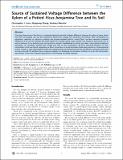Source of Sustained Voltage Difference between the Xylem of a Potted Ficus benjamina Tree and Its Soil
Author(s)
Love, Christopher J.; Zhang, Shuguang; Mershin, Andreas
DownloadLove-2008-Source of Sustained.pdf (251.6Kb)
PUBLISHER_POLICY
Publisher Policy
Article is made available in accordance with the publisher's policy and may be subject to US copyright law. Please refer to the publisher's site for terms of use.
Terms of use
Metadata
Show full item recordAbstract
It has long been known that there is a sustained electrical potential (voltage) difference between the xylem of many plants
and their surrounding soil, but the mechanism behind this voltage has remained controversial. After eliminating any
extraneous capacitive or inductive couplings and ground-mediated electric current flows, we have measured sustained
differences of 50–200 mV between the xylem region of a Faraday-caged, intact, potted Ficus benjamina tree and its soil, as
well as between its cut branches and soils and ionic solutions standardized to various pH values. Using identical platinum
electrodes, no correlation between the voltage and time of day, illumination, sap flow, electrode elevation, or ionic
composition of soil was found, suggesting no direct connection to simple dissimilar-metal redox reactions or transpirational
activity. Instead, a clear relationship between the voltage polarity and magnitude and the pH difference between xylem and
soil was observed. We attribute these sustained voltages to a biological concentration cell likely set up by the homeostatic
mechanisms of the tree. Potential applications of this finding are briefly explored.
Date issued
2008-08Department
Massachusetts Institute of Technology. Center for Biomedical Engineering; Massachusetts Institute of Technology. Department of Mechanical EngineeringJournal
PLoS ONE
Publisher
Public Library of Science
Citation
Love, Christopher J., Shuguang Zhang, and Andreas Mershin. “Source of Sustained Voltage Difference between the Xylem of a Potted Ficus benjamina Tree and Its Soil.” PLoS ONE 3.8 (2008): e2963. ©2008 Love et al.
Version: Final published version
ISSN
1932-6203